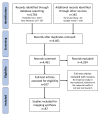Maternal health and Indigenous traditional midwives in southern Mexico: contextualisation of a scoping review
- PMID: 34949629
- PMCID: PMC8710897
- DOI: 10.1136/bmjopen-2021-054542
Maternal health and Indigenous traditional midwives in southern Mexico: contextualisation of a scoping review
Abstract
Objectives: Collate published evidence of factors that affect maternal health in Indigenous communities and contextualise the findings with stakeholder perspectives in the Mexican State of Guerrero.
Design: Scoping review and stakeholder fuzzy cognitive mapping.
Inclusion and exclusion: The scoping review included empirical studies (quantitative, qualitative or mixed methods) that addressed maternal health issues among Indigenous communities in the Americas and reported on the role or influence of traditional midwives before June 2020. The contextualisation drew on two previous studies of traditional midwife and researcher perspectives in southern Mexico.
Results: The initial search identified 4461 references. Of 87 selected studies, 63 came from Guatemala and Mexico. Three small randomised trials involved traditional midwives. One addressed the practice of traditional midwifery. With diverse approaches to cultural differences, the studies used contrasting definitions of traditional midwives. A fuzzy cognitive map graphically summarised the influences identified in the scoping review. When we compared the literature's map with those from 29 traditional midwives in Guerrero and eight international researchers, the three sources coincided in the importance of self-care practices, rituals and traditional midwifery. The primary concern reflected in the scoping review was access to Western healthcare, followed by maternal health outcomes. For traditional midwives, the availability of hospital or health centre in the community was less relevant and had negative effects on other protective influences, while researchers conditioned its importance to its levels of cultural safety. Traditional midwives highlighted the role of violence against women, male involvement and traditional diseases.
Conclusions: The literature and stakeholder maps showed maternal health resulting from complex interacting factors in which promotion of cultural practices was compatible with a protective effect on Indigenous maternal health. Future research challenges include traditional concepts of diseases and the impact on maternal health of gender norms, self-care practices and authentic traditional midwifery.
Keywords: maternal medicine; primary care; public health; social medicine; statistics & research methods.
© Author(s) (or their employer(s)) 2021. Re-use permitted under CC BY-NC. No commercial re-use. See rights and permissions. Published by BMJ.
Conflict of interest statement
Competing interests: None declared.
Figures


References
-
- Jordan B. Birth in four cultures: a crosscultural investigation of childbirth in Yucatan, Holland, Sweden, and the United States. 4th edn. Long Grove, IL: Waveland Press, 1993.
-
- United Nations (Department of Economic and Social Affairs) . Permanent Forum on Indigenous Issues. State of the World’s indigenous peoples. New York: United Nations, 2014. http://www.un.org/esa/socdev/unpfii/documents/2015/sowip2volume-ac.pdf
Publication types
MeSH terms
LinkOut - more resources
Full Text Sources
